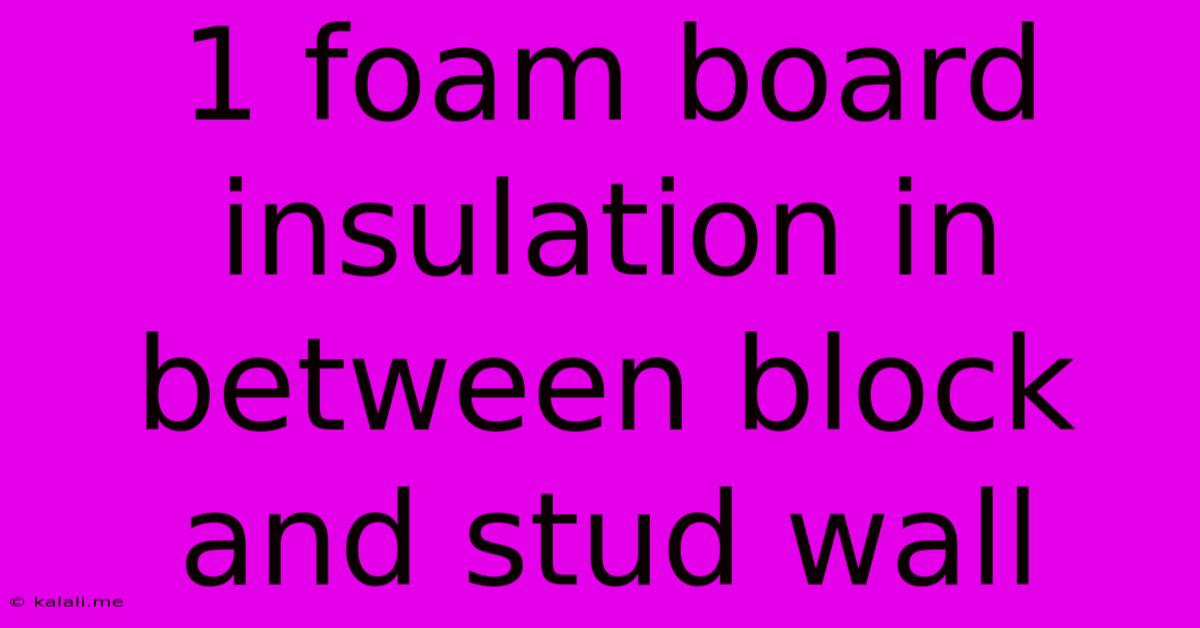1 Foam Board Insulation In Between Block And Stud Wall
Kalali
May 23, 2025 · 3 min read

Table of Contents
1-Inch Foam Board Insulation Between Block and Stud Wall: A Comprehensive Guide
Insulating your home effectively is crucial for both energy efficiency and comfort. For those with block and stud walls, incorporating foam board insulation offers a significant upgrade in thermal performance. This article explores the benefits, installation process, and considerations for using 1-inch foam board insulation between your block and stud wall. This method enhances your home's insulation and contributes to lower energy bills and a more comfortable living environment.
Understanding the Need for Insulation in Block and Stud Walls
Block and stud wall construction, common in many homes, presents a unique insulation challenge. The cavity between the exterior blockwork and the interior stud wall can create thermal bridging – areas where heat escapes easily. This leads to higher heating and cooling costs and uneven temperatures throughout the house. Adding 1-inch foam board insulation effectively addresses this issue by filling the cavity and reducing heat transfer. This is particularly beneficial in climates with significant temperature fluctuations.
Benefits of Using 1-Inch Foam Board Insulation
- Improved Thermal Performance: The primary benefit is significantly improved insulation, leading to reduced heat loss in winter and heat gain in summer. This results in lower energy bills and a more stable indoor temperature.
- Reduced Thermal Bridging: Foam board effectively minimizes thermal bridging, preventing heat from escaping through the gaps and improving the overall insulation R-value of the wall assembly.
- Cost-Effective Solution: Compared to other insulation methods, foam board insulation is relatively inexpensive and easy to install, making it a cost-effective way to enhance your home's energy efficiency.
- Moisture Resistance: Some foam boards offer excellent moisture resistance, preventing dampness from penetrating the wall and causing mold or mildew growth. This is particularly important in areas with high humidity.
- Ease of Installation: 1-inch foam boards are relatively easy to handle and install, making it a DIY-friendly project for many homeowners.
Step-by-Step Installation Guide
The installation process requires careful planning and execution. While a detailed walkthrough is beyond the scope of this article, here’s a general overview:
- Preparation: Thoroughly clean the cavity between the block and stud wall. Remove any debris or obstructions.
- Measurement and Cutting: Accurately measure the cavity depth and width. Cut the foam boards to the required dimensions, ensuring a snug fit.
- Installation: Carefully insert the foam boards into the cavity, ensuring a continuous layer with minimal gaps. Use appropriate fasteners or adhesive to secure them firmly in place.
- Vapor Barrier (Optional): Depending on your climate and wall construction, you may consider installing a vapor barrier on the interior side of the insulation to prevent moisture buildup.
- Finishing: Once the insulation is installed, proceed with the interior wall finishing, such as drywall installation and painting.
Choosing the Right Foam Board
Different types of foam board insulation exist, each with its own properties and advantages. Consider factors like R-value, moisture resistance, and compressive strength when making your selection. Common types include extruded polystyrene (XPS) and expanded polystyrene (EPS). Consult with a building professional for advice tailored to your specific climate and building code requirements.
Considerations and Precautions
- Air Gaps: Avoid leaving any significant air gaps between the foam boards and the surrounding surfaces. These gaps can compromise the insulation's effectiveness.
- Moisture Management: Properly manage moisture to prevent problems like mold and mildew growth. Ensure adequate ventilation and consider a vapor barrier if necessary.
- Building Codes: Adhere to all relevant building codes and regulations in your area. Consult with local authorities if you have any questions or concerns.
- Professional Installation: For large projects or complex wall configurations, it’s advisable to seek assistance from a qualified insulation installer.
By strategically installing 1-inch foam board insulation between your block and stud wall, you can significantly improve your home's energy efficiency, comfort, and overall value. Remember to plan carefully, choose appropriate materials, and follow best practices for installation to achieve optimal results. This relatively simple upgrade offers a substantial return on investment and contributes to a greener, more sustainable home.
Latest Posts
Latest Posts
-
Rotating And Scaling Interpretation Of Dividing Complex Numbers
May 23, 2025
-
Wp Hide Plugin Updates And Warnings Plugin
May 23, 2025
-
How To Strip Paint From Wood
May 23, 2025
-
Car Does Not Make Any Sound When Trying To Start
May 23, 2025
-
Test For Broken Symbolic Link Perl
May 23, 2025
Related Post
Thank you for visiting our website which covers about 1 Foam Board Insulation In Between Block And Stud Wall . We hope the information provided has been useful to you. Feel free to contact us if you have any questions or need further assistance. See you next time and don't miss to bookmark.